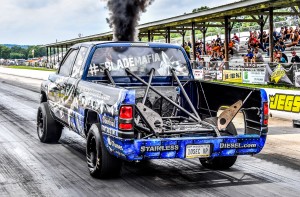The History of Truck Racing
When most people think of racing, they usually picture NASCAR cars or horses running in circles, but there’s an entirely different breed of racing that has a rich and varied history. Let’s take a closer look at the history of truck racing.
Smokey and the Bandit II
We can thank the 1979 sequel to Smokey and the Bandit for the inception of truck racing. The first truck race was featured in the opening scenes of this movie, taking place on the Atlanta Motor Speedway on June 17, 1979. The sport started as the American Truck Racing Association and transitioned into the Great American Truck Racing Circut when N. Linn Henndershott purchased the competition in 1982.
Most of the truck used in these early races were work trucks with tandem rear axles that still had their street tires attached. Truck races took place on both dirt and paved oval tracks, and in spite of the lack of modification to the vehicles, these trucks were able to attain speeds of 150mph or more efficiently.
These races only lasted until 1993, when the Great American Truck Racing circuit shut down.
The races have changed and evolved over the years, with branches popping up around the world. The FIA European Truck Racing Championship launched in 1985, and Brazil began their style of truck racing — Formula Truck — in 1996. Mexico started Tractocamiones in 1992 and continued racing until 2000. Then, Mexican truck racing came back in 2015.
Restrictions, Rules and Brands
When truck racing made its grand return to the United States, it was in the form of the Minimizer Bandit Big Rig Series, a subtle nod to Smokey and the Bandit, where the sport got its start. Some specific rules laid out, though to ensure the safety of the drivers. The minimum weight limit for participating trucks is 5500lbs, and the top speed capped at 100 mph for safety reasons.
It might not sound as exciting as the GATR races were, with their 150mph top speeds, but there’s still something eminently satisfying about watching big rigs haul tailpipe around the track at 100mph.
The manufacturers that take part in these races are as varied as the drivers behind the wheel. Everyone from Ford and Hyundai to Renault and Mercedes has manufactured racing trucks in the past for a variety of different races. Some of the vehicles, like Ford, have been known for the problems that they have both on and off the track, but unlike some races — like the 24 Hours of Le Mans — there have never been any reports of a racing truck failing to cross the finish line.
Truck racing might not be as popular as NASCAR or Formula One, but it still has a loyal and devoted following of fans who are always excited when that checkered flag falls. We might see more truck racing in the future as the sport continues to gain momentum, but that remains to be seen. One thing is sure, though — these big trucks are good at gaining momentum.

